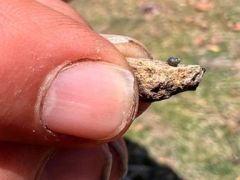RENO, Nev. — Opponents of the nation’s largest lithium mine under construction want U.S. officials to investigate whether the project in Nevada already has caused a drop in groundwater levels that could lead to extinction of a tiny snail being considered for endangered species protection.
Environmentalists and Native American activists are demanding that the U.S. Interior Department address what they say is new evidence that bolsters their concerns about Lithium Americas’ planned open pit mine at Thacker Pass. The footprint of mine operations will span about 9 square miles (23 square kilometers).
The fate of the snail takes center stage after a federal judge and an appeals court dismissed a previous attempt by Native American tribes to get federal agencies to recognize the sacred nature of the area. The tribes argued that the mine would infringe on lands where U.S. troops massacred dozens of their ancestors in 1865.
Now, Western Watersheds Project and the group known as People of Red Mountain argue in a notice of intent to sue that the government and Canada-based Lithium Americas are failing to live up to promises to adequately monitor groundwater impacts.
They say it’s alarming that an analysis of groundwater data from a nearby well that was conducted by Payton Gardner, an assistant professor of hydrogeology at the University of Montana, shows a drop in the water table of nearly 5 feet (1.5 meters) since 2018. Nevada regulators say they have no information so far that would confirm declining levels but have vowed to monitor the situation during the mine’s lifespan.
Not much bigger than a grain of rice, the Kings River pyrg has managed to survive in 13 isolated springs within the basin surrounding the mine site. It’s the only place in the world where the snail lives.
In some cases, the tiny creatures require only a few centimeters of water. But the margin for survival becomes more narrow if the groundwater system that feeds the springs begins to drop, said Paul Ruprecht, Nevada Director for Western Watersheds Project.
“Even slight disruptions to its habitat could cause springs to run dry, driving it to extinction,” he said.
Western Watersheds Project and the other opponents say the U.S. Fish and Wildlife Service is viol





